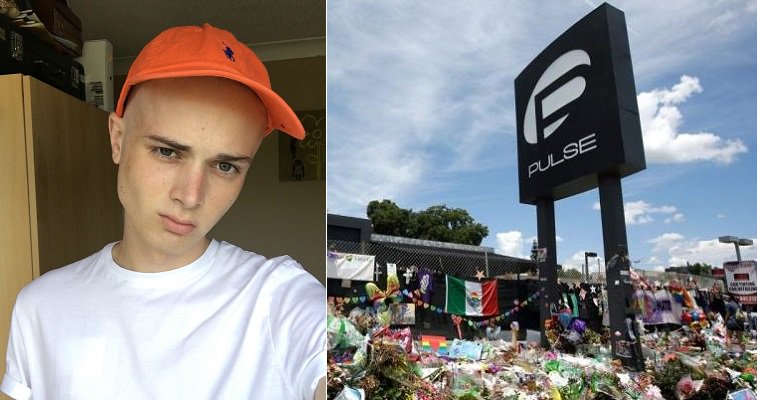Orlando: Life and hope from a place of death
By Will Stroude

This article first appeared in Attitude issue 278, January 2017.Although the impact of the Pulse massacre was felt most acutely in the city of Orlando, particularly by the queer Latino community, the pain that took place affected LGBT+ people worldwide. In the aftermath, crowds from Soho to Sydney held vigils in solidarity with those who died. The same day Dean Eastmond joined the Birmingham vigil, he was told he was critically ill. It was a bittersweet irony that the only city on Earth that offered hope for his life was also the place where 49 people had been murdered…
On 12 June 2016, Omar Mateen took the lives of 49 queer people, mainly of Latino origin, at Orlando’s Pulse nightclub, in an act regarded as the biggest attack on American people since 9/11. A day later, with the Pulse massacre still fresh on everyone’s minds, I sat uncomfortably opposite a doctor as he told me that I have cancer. To be precise, I have Ewing’s sarcoma — a rare and aggressive soft tissue and bone cancer — growing off the ninth rib on the right-hand side of my chest.
Since the day I was diagnosed, I’ve completed multiple gruelling cycles of chemotherapy, lost my hair, my house, the feeling in my fingertips and gained a new-found hatred for daytime TV.
The day I was diagnosed was also the day that thousands of people around the world took to the streets armed with rainbow flags, glitter and candles to pay their respects to the murdered 49, while landmarks across the globe lit up in rainbow colours.
I attended the vigil in Birmingham, alongside names and faces, drag queens and bar owners familiar from nights out. The sense of community was genuine; I was standing among people who cared and loved for those around them, acknowledging that it could have easily been them, me, you, us on that night in Pulse.

It was the love within the LGBT+ community after Pulse that prevented me from slipping into a dark place after diagnosis. I was able to channel my anger and fear into standing in solidarity with those around me. The vigils ignited the same overwhelming sensations felt at Pride celebrations, but with far more integrity.
One of the strongest memories I have of the vigil was thinking to myself: “I am here, I am alive, I am not alone.” Being told you have cancer is probably one of the worst things you can hear, but standing side-by-side with the queer community that night reiterated the rhetoric that cancer operates within me; I do not operate within it.
So, when I was offered the lifeline of heading to Florida for 10 weeks of treatment, it was as if this Pulse/cancer narrative had come full circle. Pulse marked the beginning of this never-ending journey with cancer and has now become a symbol of not only my treatment, but also the healing process.
I’m currently receiving a revolutionary new form of radiotherapy called proton beam therapy. The treatment localises the radiation fired at the tumour in my ribs, preventing unnecessary radiation damaging surrounding organs and stopping new tumours from being created. The treatment has yet to be introduced to the UK, although centres will open in a couple of years. With the survival rate for my type of cancer barely reaching 50 per cent, this treatment gives me a fighting chance of making it to my 21st birthday.

As I sat in my hospital bed halfway through a chemo cycle, and my lead oncologist dropped the bombshell that he was sending me across the pond in the hope of saving my life, the determination to visit Pulse was overwhelming. And visit I did.
As we arrived at the former nightclub, a sense of anxiety, sickness and the fear of the unknown lingered. Pulling into the car park next to the club saw me facing a myriad of colours, handwritten messages, pebbles with victims’ names on them and flowers lining the mural, even months later.
Local businesses proudly boast #WEAREORLANDO signs in their windows. In the air, there’s an ominous and unsettling feeling of both love and loss. Messages of mourning marry with celebrations of the lives of the victims.
“Love will always win”, a nine-year-old had written on the patchworked congregation of messages. Behind these messages lies the empty shell of a venue, still boarded up and pierced with splintered-wood bullet holes, bringing home the reality of the horrors that occurred there.

Just seeing them makes you realise how important nightclubs are as LGBT+ sanctuaries and how far we still have to go to not be scared of holding our partners’ hands in public.
The mural that protects the walls of the club, now trapped in a history of its own horrors, acts as a sanctuary and reminder of hope.
Florida’s gay community is healing, piecing back together what was lost — with strength, love and one of the best gay scenes I’ve been part of.
Of course, I’m merely a spectator of the community here, but an element of Florida’s queer pride reverberates throughout the state. Drag queens stand a little taller, club walls stand even more resilient and Pride flags fly a whole lot prouder.
Dean Eastmond is the co-founder and editor-in-chief of HISKIND magazine. You can follow him on Twitter @deanvictorr.
More stories:
Abercrombie & Fitch slammed after suggesting Pride is also for straight people
Orlando one year on: Why the greatest tribute to the 49 is to be louder and prouder than eve
